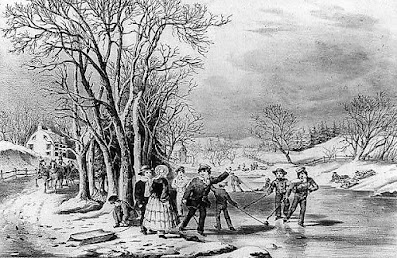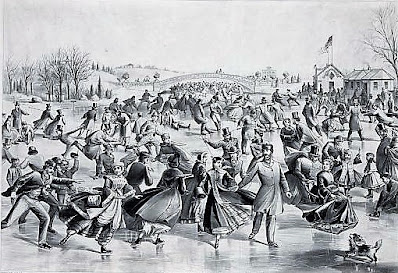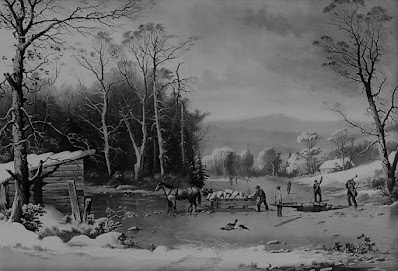From old Dutch engravings to the whimsical works of Toller Cranston and Sergey Tyukanov, artists have been reinvisioning and recreating the beauty of ice skating for centuries. No blog on figure skating history would really be complete without a nod to Currier and Ives, the famous New York City printmaking firm headed by Nathaniel Currier and James Merritt Ives. In the Victorian era, the firm mass produced inexpensive black and white and coloured engravings "for the people", advertising itself as "the Grand Central Depot for Cheap and Popular Prints". Prominent in their collection of thousands of lithographs were a host of winter scenes, many of which captured the magic of skating.
"Winter Pastime"
"Winter Pastime", which first appeared in 1855, was one of the first Currier and Ives prints to feature skating as its subject. The stark scene depicts a young boy kneeling near a large tree while he puts on his skates. He will presumably soon join his friends on the ice, who hold sticks both to test the thickness of the ice and to use as safety devices should one of their friends fall through. A horse drawn sleigh rounds the corner while children on sleds race down the opposite hill.
"Central Park - Winter, The Skating Pond"
Perhaps the most popular of Currier and Ives' lithographs was "Central Park - Winter, The Skating Pond", which was first reproduced in 1862 from a painting by Charles Parsons, who apprenticed in the lithographic studio of George Endicott and later served as the head of the art department of "Harper's Weekly". The scene depicts a large crowd of skaters dressed in the fashions of the era, skating alone and in couples. Two couples skate in the forefront, while a man pushes a woman in a sleigh with ice runners and an excited dog barks at the hullabaloo. The lithograph was later reproduced in a hand coloured form.
"Winter In The Country - Getting Ice"
1864's "Winter In The Country - Getting Ice" depicts a typical midwinter ice harvest of the era, with a horse and cart being used to haul the large blocks of ice back into town for sale. Four individuals make use of the section of the pond they're still able to practice their 'fancy' skating on. Canadian newspapers of the era frequently featured complaints that many of the 'best skating spots' were falling victim to ice harvesting. "Winter In The Country - Getting Ice" was derived from a George Henry Durrie painting. Nearly a dozen of Durrie's paintings were used by Currier and Ives, and this one - along with "The Old Homestead In Winter" and "Winter Morning" - was one of the most popular.
"Skating Scene - Moonlight"
"Skating Scene - Moonlight" was published in 1868. The piece depicts a large group of skaters skating, mostly hand in hand, on a frozen lake on a winter's evening. 1869's "Early Winter", which nearly enjoyed the same popularity as "Central Park - Winter, The Skating Pond", showcases an unlucky thirteen skaters taking to the ice for perhaps their first skate of the season on a gray November day on a pond below a charming country home.
"Early Winter"
"Central Park In Winter" was a beautiful hand-coloured lithograph that first appeared in the early 1870's. It depicts a large group of skaters enjoying an early evening skating party on a pond near a bridge. An assembly of horse-drawn sleighs line the front of the scene. These would, of course, been the transportation the skaters would have taken to and from their Victorian era skating session.
"Central Park In Winter"
Two less popular Currier and Ives lithographs, not so creatively entitled "Canadian Winter Scene" and "American Winter Scene", feature skaters on a frozen river below a forest embankment and a house with sleighs in front, with an assemblage of skaters enjoying a morning on the neighbouring pond in the distance.
Photo courtesy Skating Club Of New York
Writing in "Skating" magazine, Clarence T. Hubbard summarized, "It's as though Currier & Ives artists had a vision of twentieth-century life and painted for future as well as contemporary demand. The now famous rural scenes ignore the uglier realities of those years and depict the nineteenth century as the essence of bucolic bliss. Currier & Ives portraits... contain nary a hint of sagging fences, poor crops and hungry livestock. Life is simple; life is good. The original lithographs, which once sold for a mere six cents each, are snapped up today regardless of soaring prices by the city dweller pining for the unhurried days of yore... Distinguished Currier & Ives artists were Louis Maurer, Thomas Worth, Arthur Fitzwilliam Tait and Fanny Palmer. The fact that these talented painters depicted so many skating scenes is testimony to the importance of ice skating in nineteenth-century life. The hinterland of Currier & Ives may be disappearing, but the love of skating so evident in their prints is immutable."
Skate Guard is a blog dedicated to preserving the rich, colourful and fascinating history of figure skating. Over ten years, the blog has featured over a thousand free articles covering all aspects of the sport's history, as well as four compelling in-depth features. To read the latest articles, follow the blog on Facebook, Twitter, Pinterest and YouTube. If you enjoy Skate Guard, please show your support for this archive by ordering a copy of the figure skating reference books "The Almanac of Canadian Figure Skating", "Technical Merit: A History of Figure Skating Jumps" and "A Bibliography of Figure Skating": https://skateguard1.blogspot.com/p/buy-book.html.







